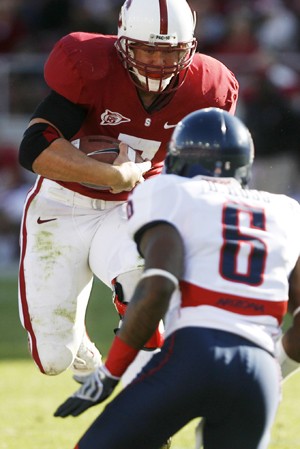Arizona began its season ranked No. 2 nationally in total defense, backed by a No. 27 rushing defense and a passing defense that was tops in the nation.
That didn’t last long, particularly in terms of defending the run.
After the Wildcats’ loss to Stanford, in which Arizona allowed 286 yards on the ground, the rushing defense may have converted from a strong point to a liability in just one game.
“”I think they controlled the line of scrimmage and that is always a concern,”” said UA head coach Mike Stoops in his weekly press conference in McKale Center on Monday. “”To be able to run the football as well as they did and control, that has happened to us a couple times this year and just didn’t get enough opportunities offensively.””
Allowing the opposition to control the game via the rushing attack has been a theme in Arizona’s two losses, as New Mexico rushed for 221 yards in the Wildcats’ first loss of the season.
Now it looks as if opposing teams have the blueprint on how to beat Arizona.
That’s not good news, considering the Wildcats will welcome California into Arizona Stadium on Saturday.
The Golden Bears, who are still undefeated in Pacific 10 Conference play, sport a solid rushing attack backed by explosive running back Jahvid Best, who is averaging more than 7 yards per carry through five games. Best has 59 carries for Cal, which totaled to 421 yards and four touchdowns.
Perhaps Best’s biggest performance came against Washington State, where he rushed only 14 times but gained 200 rushing yards and found the end zone on three different occasions.
The Wildcats know they have their work cut out for them Saturday.
“”It wasn’t necessarily that (Stanford) was knocking us off the ball, but I thought we were a little soft on a couple plays,”” Stoops said. “”I think (Stanford’s) physical presence comes from their back. (Running back Toby Gerhart) is a very physical runner.
“”I think any team’s success is based onÿ- look at our team’s success – the run game. “”If you can have the ability to run the football and be multidimensional, it can really keep a team off balance.””
Which is why Arizona needs to figure out a way to stop teams from running all over them.
Behind Gerhart, the Wildcats had their hands full with a very underrated Stanford rushing attack. Even so, Arizona players admitted they could have defended better and that was most likely the difference in the game.
“”They moved a lot of guys around and got us out of position,”” said UA defensive end Brooks Reed.
After being controlled in the defensive trenches, the Wildcats are expecting opposing teams to continue attacking what seems to be their weakness after their loss to the Cardinal.
Defensive end Ricky Elmore said he realizes the defensive line must go back to the drawing board if it wishes to contend with some of the tough teams remaining on the schedule.
“”If they were smart, they would probably try and do that,”” Elmore said of other teams planning to attack Arizona on the ground. “”This is something that we are probably going to stick with and work all week, because in our two losses (rushing defense) has hurt us a lot.””
Home field advantage seems to matter for ‘Cats
Take home field advantage for what it’s worth.
While some would argue location of the game is irrelevant most of the time, the Arizona football team has shown that it does make a difference, as both the Wildcats’ losses have happened on the road.
Stoops is convinced his team is given a boost when playing in front of its home crowd.
“”I think the comforts of being home, offensively (we seem) to play better,”” Stoops said. “”I think it picks up both sides of the field. It picks you up in a lot of different areas. On the road you are usually going to be in tough situations. You got to really concentrate on your execution.””
Though Arizona’s remaining schedule will certainly be tougher than previous competition thus far this season – the Wildcats have yet to face conference leaders Cal, USC and Oregon – the good news is four of Arizona’s remaining six games are at home.
Arizona will not have to hit the road until November when it travels to Pullman, Wash., to take on Washington State.
Until then, the Wildcats hope to rebound from a tough loss to Stanford in front of their home crowd. As of now, the toughest road game remaining on Arizona’s schedule is a visit to Autzen Stadium in Eugene, Ore., to take on Oregon.
“”I think it is easier,”” Stoops said of playing at home. “”I think these offenses are so complex and trying to get the operation the way it needs to be and there is always motivation at home. Your crowd supports you so much stronger at home than you do on the road.
“”That’s a big thing and it’s a big factor,”” Stoops added. “”I hope we can get a lot of energy in our stadium this week, create an atmosphere that this is a big game for us, and hopefully that will help us.””
Stoops brothers had tough weekend
It wasn’t a good weekend for the Stoops brothers.
While Mike Stoops’ Arizona squad lost a heartbreaker to Stanford, Bob Stoops, head coach of No. 4 Oklahoma, endured perhaps a more painful loss to Texas in the “”Red River Showdown.””
Even with both squads losing, Mike Stoops said the two didn’t console each other about the losses.
“”It’s part of the game,”” Mike Stoops said. “”You just kind of move on.””









